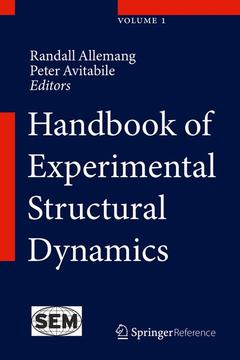Description
Handbook of Experimental Structural Dynamics, 1st ed. 2022
Coordinators: Allemang Randall, Avitabile Peter
Language: English
Subjects for Handbook of Experimental Structural Dynamics:
Keywords
History of Experimental Structural Mechanics; Experimental Dynamic Modeling; Experimental Modal Analysis; Digital Signal Processing and Measurements; Measuring Devices (accelerometers; force; laser; optical); Design of Modal Tests; Correlation; Updating; Analytical and Experimental Substructuring; Nonlinear Analysis Methods (Analytical and Experimental Methods); Structural Health Monitoring; Applications in Various Industries
1426 p. · 15.5x23.5 cm · Hardback
Description
/li>Contents
/li>Biography
/li>Comment
/li>
The SEM Handbook of Experimental Structural Dynamics stands as a comprehensive overview and reference for its subject, applicable to workers in research, product design and manufacture, and practice. The Handbook is devoted primarily to the areas of structural mechanics served by the Society for Experimental Mechanics IMAC community, such as modal analysis, rotating machinery, structural health monitoring, shock and vibration, sensors and instrumentation, aeroelasticity, ground testing, finite element techniques, model updating, sensitivity analysis, verification and validation, experimental dynamics sub-structuring, quantification of margin and uncertainty, and testing of civil infrastructure. Chapters offer comprehensive, detailed coverage of decades of scientific and technologic advance and all demonstrate an experimental perspective. Several sections specifically discuss the various types of experimental testing and common practices utilized in the automotive, aerospace, and civil structures industries.
· History of Experimental Structural Mechanics
· DIC Methods - Dynamic Photogrammetry
· LDV Methods
· Applied Digital Signal Processing
· Introduction to Spectral - Basic Measurements
· Structural Measurements - FRF
· Random and Shock Testing
· Rotating System Analysis Methods
· Sensors Signal Conditioning Instrumentation
· Design of Modal Tests
· Experimental Modal Methods
· Experimental Modal Parameter Evaluation
· Operating Modal Analysis Methods
· Analytical Numerical Substructuring
· Finite Element Model Correlation
· Model Updating
· Damping of Materials and Structures
· Model Calibration and Validation in Structures
· Uncertainty Quantification: UQ, QMU and Statistics
· Nonlinear System Analysis Methods (Experimental)
· Structural Health Monitoring and Damage Detection
· Experimental Substructure Modeling
· Modal Modeling
· Response (Impedance) Modeling
· Nonlinear Normal Mode Analysis Techniques (Analytical)· Modal Modeling with Nonlinear Connection Elements (Analytical)
· Acoustics of Structural Systems (VibroAcoustics)
· Automotive Structural Testing
· Civil Structural Testing
· Aerospace Perspective for Modeling and Validation
· Sports Equipment Testing
· Applied Math for Experimental Structural Mechanics
Contributions present important theory behind relevant experimental methods as well as application and technology. Topical authors emphasize and dissect proven methods and offer detail beyond a simple review of the literature. Additionally, chapters cover practical needs of scientists and engineers who are new to the field. In most cases, neither the pertinent theory nor, in particular, the practical issues have been presented formally in current academic textbooks. Each chapter in the Handbook represents a ?must read? for someone new to the subject or for someone returning to the field after an absence. Reference lists in each chapter consist of the seminal papers in the literature.
This Handbook stands in parallel to the SEM Handbook of Experimental Solid Mechanics, where this Handbook focuses on experimental dynamics of structures at a macro-scale often involving multiple components and materials where the SEM Handbook of Experimental Solid Mechanics focuses on experimental mechanics of materials at a nano-scale and/or micro-scale.
Provides only comprehensive coverage of experimental methods in structural mechanics
Presents extensive explanation of underlying theory and details practical methods used in industry and research
Focuses on important concepts, methods, techniques in use of instrumentation without commercial bias




